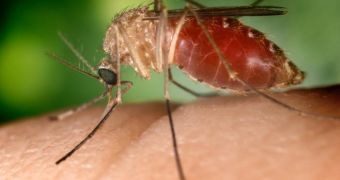A team of researchers from Purdue University have made an amazing discovery regarding the West Nile virus: when a certain antibody binds to it, it manages to lock up the infection mechanism and neutralize it.
This could be a major step towards developing a vaccine against this mosquito-borne illness, said Michael Rossmann, the Hanley Distinguished Professor of Biological Sciences in Purdue's College of Science
“There are many antibodies that can neutralize West Nile virus,” he explained, but “these findings concern a specific antibody, called CR4354, [which] uses an unusual approach to neutralize the virus.
“Normally an antibody binds to a single molecule, but now we see this crosslinking, which is quite clever because it ties everything rigidly together.”
To understand this process, the researchers used cryoelectron microscopy, which allowed them to take detailed pictures of the Fab-virus complex, and they also used X-ray crystallography to study the specific crystalline structure of the antibody.
What they found was that a key part of the antibody which is called the antigen binding fragment (Fab) attaches to two neighboring protein molecules that make up the virus's outer shell.
This sort of crosslinking attachment between molecules, is repeated over the entire shell, connecting the 30 molecular piles that make it up and preventing any structural changes that are necessary for the virus to infect host cells.
Rossmann explained that “the antibody crosslinking causes the virus to become rigid, and this rigidity prevents conformational changes to the virus needed to fuse with host cells.”
The researchers' team included postdoctoral researcher Bèrbel Kaufmann, other researchers at Purdue, the Washington University School of Medicine in St. Louis and the biotechnology company Crucell Holland B.V., in The Netherlands.
The West Nile virus is part of the flaviviruses family, which includes most dangerous insect-borne disease-causing viruses, and it can cause a possibly fatal disease.
The virus is widespread in parts of Africa, Asia and Europe, but during the past ten years, it has spread throughout North America and into Central and South America.
It has infected thousands of people in the United States over the past five years and killed over 400, according to the Centers for Disease Control and Prevention.
The results of this new research are detailed in a paper that appeared in October in Proceedings of the National Academy of Sciences.

 14 DAY TRIAL //
14 DAY TRIAL //